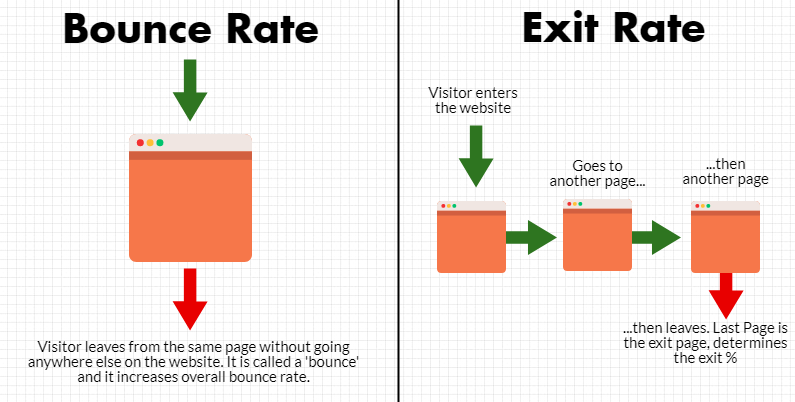Understanding the Difference Between Bounce & Exit Rate

We have spent much time in comprehending the bounce rate metric, and its impact on web pages and a website as a whole. However, Google Analytics has another critical metric called ‘Exit Rate’, that cannot be ignored and is equally important to understand. Unfortunately, these two metrics are misunderstood a lot.
Difference Between Bounce and Exit Rate
Let’s dive into the definition of these metrics
Bounce Rate is the percentage of visitors visiting a webpage and then ‘bounce back’ or leave that page immediately without visiting any other web pages on the website they are navigating.
On the other hand, Exit Rate is the percentage of visitors that leave a website from that page. In Exit Rate, the visitors have viewed more than one page in a session.
There is a difference, however. Let’s understand the Exit Rate with the following example:
A user visited your website via organic search listing. They read your blog, then visited the ‘about us’ section and finally landed on the ‘contact us’ page where they clicked on the ‘contact us’ link to fill the signup form. After filling the form, they exited the page.
The user exited from the ‘Contact Us’ page. In contrast, if the user would have visited the website via an organic search listing and left without visiting any other page, in that situation, we would call it a ‘bounce.’
The Most Important Metric
Analysing both the metrics is critical. One metric is not enough to provide any actionable insight. Let’s understand how.
Bounce Rate can easily highlight the problem relating to the content, site quality and website loading time. It will provide the reason for the loss of a user when they land on a specific page.
Whereas, Exit Rate helps in identifying the problems in the conversion path or user buying journey. This metric gives an overview of how users navigate the website which further helps in determining the loopholes. Therefore, the choice of metrics should be based on the problem area.
How to Deal with High Exit Rate Pages?
Exit Rate percentage depends on the type of web pages. For example – The Contact Us page will have a high exit percentage because people are navigating to locate the address or phone number and may convert differently. So, the high exit percentage is not alarming. Whereas, if the high exit percentage is on the product or service page, then there is a loss of revenue. This is where it is critical to analyse why people are abandoning a particular page and the behaviour flow.
Here are some factors that help in reducing the high exit rate:
Easy Navigation – User experience (UX) is paramount. Navigating through the website should be smooth and less complicated. Even the visitor who’s visiting for the first time should not have any problem while browsing the website.
Call to Action – The CTA (Call to Action) button should be strategically placed on the key web pages such as the ones the oversee maximum conversions. Strategic placement removes the ambiguity from a visitor’s mind about where the click will take them.
External Link in New Tab – All anchor links should open in a new tab to lower the exit rate. By adopting this practice, the visitor will never be forced to leave the page immediately.
Provide Information Before ‘Add to Cart’ – Transparency is a key to reducing the exit rate during the user buying journey.
• Be transparent about the charges like shipping & other costs
• Provide information such as reviews from past visitors for prompt conversion
Analysis of Site Search Terms – Sometimes the resulting pages from the search term have a high exit rate. Analyse the search term on the website and see the corresponding web pages. If people are searching for unrelated terms via a search engine, analyse the cause of the issue.


